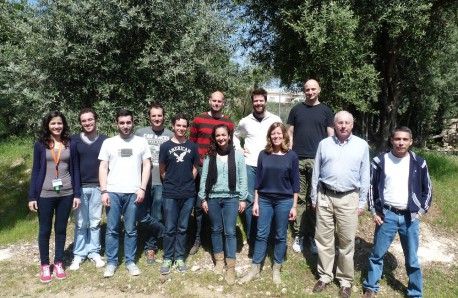Ballester
Research group

RESEARCH ABSTRACT
Our research is focused in the design, synthesis and study of functional molecular aggregates. We tackle the thermodynamic characterization of self-assembly processes as a methodology to construct large and functional multimolecular architectures. We are also active in the design and synthesis of new synthetic hetroditopic receptors for ion-pairs. Another area of our interest resides in the design and application of molecular containers. These are molecules or supramolecules which are sufficiently large to include or encapsulate other molecules. We investigate the effect that the confinement of molecules in reduced nanoscopic spaces may have in modifying their chemical reactivity. We are also interested in the synthesis of mechanically interlocked molecules (MIM) i.e. catenanes and rotaxanes, which have potential applications in molecular machinery.
Topics addressed
- Encapsulation studies of organometallic complexes
- Anion- p interactions
- Kinetic stabilization of organic compounds using molecular containers
- Receptors for ion-pair dimers and ion-quartets
Articles
“Encapsulation Studies of Cationic Gold Complexes within a Self-Assembled Hexameric Resorcin[4]arene Capsule”
Eur. J. Org. Chem., 2013, 1494-1500
L. Adriaenssens, A. Escribano-Cuesta, A. Homs, A.M. Echavarren and P. Ballester
“Experimental Quantification of Nitrate−π Interactions and Selective Transport of Nitrate Using Calix[4]pyrroles with Two Aromatic Walls”
J. Am. Chem. Soc., 2013, 135, 8324-8330
L. Adriaenssens, C. Estarellas, A. Vargas Jentzsch, M. Martinez Belmonte, S. Matile and P. Ballester
“Different Nature of the Interactions between Anions and HAT(CN)6: From Reversible Anion−π Complexes to Irreversible Electron-Transfer Processes (HAT(CN)6 = 2,3,6,7,10,11-hexacyano-1,4,5,8,9,12-Hexaazatriphenylene”
J. Am. Chem. Soc., 2013, 135, 2620-2627
G. Aragay, A. Frontera, V. Lloveras, J. Vidal-Gancedo and P. Ballester.
“Quantification of Anion−π Interactions in Solution Using Neutral Host–Guest Model Systems”
Acc. Chem. Res., 2013, 46, 874-884
P. Ballester
“Kinetic Stabilization of N,N-Dimethyl-2-propyn-1-amine N-Oxide by Encapsulation”
Org. Lett., 2013, 15, 4976-4979
A. Galán, G. Gil-Ramírez and P. Ballester
“Mechanisms of Catalysis in Confined Spaces: Hydrogenation of Norbornadiene with a Rhodium Complex included in a Self-Folding Cavitand”
Curr. Org. Chem., 2013, 17, 1499-1506
A. Hamilton, M. Gicquel, P. Ballester and C. Bo
“Cooperative Binding of Ion-Pair Dimers and Ion Quartets by a Bis(calix[4]pyrrole) Macrotricyclic Receptor”
Angew. Chem., Int. Ed., 2013, 52, 6898-6902
V. Valderrey, E.C. Escudero-Adán, P. Ballester
“Hydrogen bonded supramolecular capsules with functionalized interiors: The controlled orientation of included guests”
Chem. Soc. Rev. 2013, 42, 3261-3277
L. Adriaenssens, P. Ballester